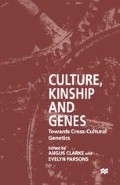Abstract
The gene that concerns us most in Nigeria is the sickle cell (S) gene, which causes sickle cell anaemia (SCA), also known as sickle cell disease (SCD). SCA is the most common hereditary disorder in the world (WHO 1994), and is caused by the inheritance of a mutant sickle haemoglobin (HbS) from each parent. Its incidence is highest in sub-Saharan Africa (Livingstone 1967), from where the gene has spread by migration to Europe and especially the Americas. To the title of this volume — Culture, Kinship and Genes — I would like to add Geography, as it is the geographical endowment of sub-Saharan Africa — hot, lush and humid — which has favoured the survival and growth of the gene among the indigenous population.
Access this chapter
Tax calculation will be finalised at checkout
Purchases are for personal use only
Preview
Unable to display preview. Download preview PDF.
References
Akinyanju, O.O. 1989 A profile of sickle cell disease in Nigeria. Annals of the New York Academy of Sciences 565: 126–36.
Akinyanju, O.O., & Anionwu, E.N. 1989 Training of counsellors on sickle cell disorders in Africa. Lancet 1: 653–4.
Allison, A.C. 1954 Protection afforded by sickle cell trait against subtertian malarial infection. BMJ 1: 290–4.
Angastiniotis, M.A., & Hadjimanas, M.G. 1981 Prevention of thalassaemia in Cyprus. Lancet 1: 369–71.
Bernstein, R.E. 1969 Sickle haemoglobin in South Africa. South African Medical Journal 43: 1455–6.
Edington, G.M., & Watson-Williams, E.J. 1965 Sickling, haemoglobin C, glucose-6-phosphate dehydrogenase deficiency and malaria in Western Nigeria, in Jonxis, J.H.P. (ed.) Abnormal Haemoglobins in Africa. Blackwell: Oxford, pp. 393–401.
Fleming, A.F., Storey, J., Molineaux, L., Iroko, E.A., & Attai, E.D.E. 1979 Abnormal haemoglobins in the Sudan savanna of Nigeria. I: Prevalence of haemoglobins and relationships between sickle cell trait, malaria and survival. Annals of Tropical Medicine and Parasitology 73: 161–72.
Foy, H. et al. 1952 The distribution of sickle cell trait and the incidence of sickle cell anaemia in the Negro tribes of Portuguese East Africa. East African Medical Journal 29: 247–51.
Godlee, F. 1994 The World Health Organization: the regions — too much power, too little effect. BMJ 309: 1566–70.
Herrick, J.B. 1910 Peculiar elongated and sickle-shaped red blood corpuscles in a case of severe anaemia. Archives of Internal Medicine 6: 517–21.
Jellife, D.B., & Humphreys, J. 1952 The sickle cell trait in Western Nigeria. BMJ 1: 405–6.
Konotey-Ahulu, F.I.D. 1991 The Sickle Cell Disease Patient. Macmillan: London.
Livingstone, F.B. 1967 Abnormal Haemoglobins in Human Populations: A summary and interpretation. Aldine: Chicago.
Livingstone, F.B. 1971 Malaria and human polymorphisms. Annual Review of Genetics 5: 33–64.
Luzzatto, L. 1975 Genetic counselling in haemoglobinopathies. Dokita 7: 65–8.
Mabayoje, J.O. 1956 Sickle cell anaemia: a major disease in West Africa. BMJ 1: 194–6.
Molineaux, L., Fleming, A.F., Cornille-Brogger, R., Kagan, I., & Storey, J. 1979 Abnormal haemoglobins in the Sudan savanna of Nigeria. III: Malaria, immunoglobulins and antimalarial antibodies in sickle cell disease. Annals of Tropical Medicine and Parasitology 73: 301–10.
Pagnier, J., Mears, J.G., Dunda-Belkhodja, O., Schaffer-Rego, K.E., Beldjord, C., Nagel, R.L., & Labie, D. 1984 Evidence for the multicentric origin of the sickle cell hemoglobin gene in Africa. Proceedings of the National Academy of Sciences of the USA 81: 1771–3.
Raper, A.B. 1950 Sickle cell disease in Africa and America — comparison. Journal of Tropical Medicine 53: 49–53.
Reys, L., Manso, C., Stamatoyannopoulos, G. et al. 1972 Genetic studies on South-Eastern Bantu of Mozambique. II: Serum groups, hemoglobins and red cell isozyme phenotypes. Hymangenetik 16: 227–33.
Trabuchet, G., Elion, J., Baudot, G., Pagnier, J., Bouhass, R., Nigon, V.M., Labie, D., & Krishnamoorthy, R. 1991 Origin and spread of beta-globin gene mutations in India, Africa and Mediterranea: analysis of 5 flanking and intragenic sequences of beta S and beta C genes. Human Biology 63: 241–52.
Walters, J.H., & Lehmann, H. 1956 Distribution of the S and C haemoglobin variants in two Nigerian communities. Transactions of the Royal Society of Tropical Medicine and Hygiene 50: 204–8.
World Health Organization 1987 Proposal for a Feasibility Study on the Control of Sickle Cell Disease in Africa. Report of a WHO Informal Consultation. WHO/HDP/SCD/87.3.
World Health Organization 1994 Guidelines for the Control of Haemoglobin Disorders. WHO/HDP/HB/GL/94.1
Editor information
Editors and Affiliations
Copyright information
© 1997 Palgrave Macmillan, a division of Macmillan Publishers Limited
About this chapter
Cite this chapter
Akinyanju, O. (1997). Coping with the Sickle Cell Gene in Africa. In: Clarke, A., Parsons, E. (eds) Culture, Kinship and Genes. Palgrave Macmillan, London. https://doi.org/10.1007/978-1-349-25882-6_10
Download citation
DOI: https://doi.org/10.1007/978-1-349-25882-6_10
Publisher Name: Palgrave Macmillan, London
Print ISBN: 978-1-349-25884-0
Online ISBN: 978-1-349-25882-6
eBook Packages: Palgrave Social & Cultural Studies CollectionSocial Sciences (R0)

